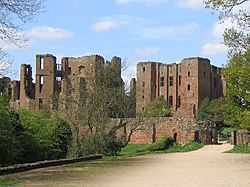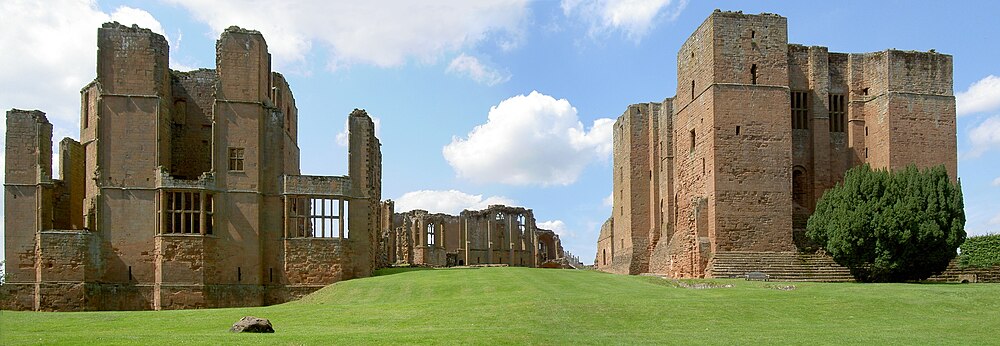Kenilworth Castle
| Kenilworth Castle | |
|---|---|
 Kenilworth Castle, Warwickshire | |
| Lua error in Module:Location_map at line 411: Malformed coordinates value. | |
| General information | |
| Town or city | Kenilworth, Warwickshire |
| Country | England |
| Coordinates | grid reference SP2794172163 |
| Construction started | 1220s |
| Demolished | 1656 |
Kenilworth Castle is a castle located in Kenilworth, Warwickshire, England. The medieval castle is known for its extensive water defences, and the great siege by the future Edward I in 1266, plus the ruins of the ornate Great Hall built by John of Gaunt. Its later history includes the visit of Elizabeth I (it still boasts Tudor buildings and gardens) and the dramatic slighting by Cromwell's troops, leaving an open side to the fine Norman keep.
History

Kenilworth Castle was founded in the 1120s. The castle's original form is uncertain; it has been suggested that it consisted of a motte (an earthen mound) surmounted by wooden buildings, however the stone keep which is still standing may have been part of the original design. Geoffrey de Clinton, who founded the castle and Kenilworth Abbey, relied on king Henry I for personal advancement. In the 1120s, Geoffrey de Clinton was favoured by the king and was promoted to sheriff in Warwickshire to act as a balance to the influence of Roger de Beaumont, 2nd Earl of Warwick.[1] Amongst Roger's possessions was Warwick Castle, just 5 miles (8.0 km) south of Kenilworth, and Henry was suspicious of his loyalties. When Geoffrey died in around 1133, he was succeeded by his son, also called Geoffrey. Geoffrey II was a minor when his father died and Roger's power in Warwickshire was increasing. Geoffrey and his uncle, William de Clinton, came to terms with the Earl of Warwick, causing Geoffrey to lose royal favour. Under Geoffrey II, little work was undertaken at Kenilworth or Brandon Castle – the other castle owned by the De Clinton family.[2] During the Revolt of 1173–1174 Kenilworth was garrisoned for Henry II; Geoffrey II de Clinton died in this period and the castle was taken into royal possession.[3]
While activities at Kenilworth under the De Clinton family are mostly a matter of speculation, royal records (Pipe Rolls) provide more detail. From these records the castle's form when it was taken into royal control is known: the current stone keep was present and there was a bailey attached – an enclosed courtyard where ancillary buildings were located – which was accessed by a causeway across a lake. Under kings Henry III and John, Kenilworth's outer defences were extended, and the castle took on its current shape defined by the curtain wall. The outer bailey was defended by a bank and ditch at this point, although it had a simple stone gatehouse. The walls of the inner bailey were probably rebuilt in stone by Henry II. When John was excommunicated in 1208, he embarked on a programme of rebuilding and enhancing major royal castles; this included spending £1,100 on Kenilworth Castle between 1210 and 1215.[3]
However, after all the work to improve the castle, Henry III granted it in 1244 to Simon de Montfort, Earl of Leicester. Simon de Montfort became a leader in the Second Barons' War (1263-1267) against Henry III, using Kenilworth as the centre of his operations. Prince Edward, Henry's heir, was once briefly imprisoned at Kenilworth before escaping. De Montfort was killed in battle near Evesham on August 13, 1265 facing Edward. In 1266, the rebels under the leadership of Henry de Hastings, used the castle as a refuge when Lord Edward surrounded Kenilworth. The Siege of Kenilworth Castle in 1266 is the longest in English history. The extensive water defences provided their intended protection, despite Edward targeting the weaker north wall, defended by only a double moat, employing huge siege towers and even attempting a night attack by barge. The siege was ended on easy terms for the defenders with the Dictum of Kenilworth. The experience gained in water defences at Kenilworth was put to good effect at later castles built in Wales, notably Caerphilly.
Henry III bestowed the castle upon his youngest son Edmund Crouchback. The castle was inherited by Edmund's grandson Henry of Grosmont, 1st Duke of Lancaster, and then passed to the Duke's son-in-law John of Gaunt.
From 1364, John of Gaunt began the castle's conversion from a pure fortress into something more liveable, work that continued with his grandson, Henry V. The castle remained in royal hands until it was given to John Dudley in 1553. Following his execution Elizabeth I gave it to her favourite Robert Dudley, Earl of Leicester[4] in 1563. Thomas Underhill was named Keeper of the Wardrobe at this time. Dudley further transformed the castle by making the north entrance the main entrance to suit the tastes of Elizabeth, adding the Leicester building, a large apartment and a residential block overlooking the lake.
Elizabeth visited Dudley at Kenilworth Castle several times in 1566, 1568, 1572, and 1575. The last visit is especially remembered, when Elizabeth brought an entourage of several hundred. No expense was spared for the July visit that lasted 19 days and is reputed to have cost Dudley £1000 per day (£Error when using {{Inflation}}: |end_year=2,024 (parameter 4) is greater than the latest available year (2,023) in index "UK". as of 2024),[5] an amount that almost bankrupted him. Dudley entertained the Queen with pageants, bear baiting and lavish banquets that surpassed anything ever before seen in England.[6][7]
The festivities are said to have been the inspiration for Shakespeare's A Midsummer Night's Dream. William Shakespeare was just 11 years old at the time and from nearby Stratford-upon-Avon. He could well have been among the crowd of locals that would have gathered to witness the occasion with its expensive and lavish arrangements.[8]

Sir Walter Scott wrote an 1821 novel describing the royal visit, and Sir Arthur Sullivan wrote a choral work in 1864 about it.[9] Elizabeth is said, according to local legend, to have tasted the first potato brought into the country at Kenilworth Castle. Unfortunately, she ate it raw, disliked it and threw it out the window where it grew in an area now known as Little Virginia.
The castle returned to the Crown on Dudley's death. In the English Civil War, the castle was stormed and looted by Parliamentarian troops. In common with many English castles, Kenilworth was slighted (rendered indefensible) after the Civil War. One wall of the keep was blown up, and battlements and the great water defences were destroyed, in 1656.
In 1660 Charles II gave the castle to Sir Edward Hyde, whom he created Baron Hyde of Hindon and Earl of Clarendon. The castle remained the property of the Clarendons until 1937 before passing into the possession of John Davenport Siddeley, 1st Baron Kenilworth. The family presented the castle to Kenilworth in 1958 and English Heritage has looked after it since 1984.
In 2005 English Heritage announced that after archaeological investigations revealed more details of the original garden, it would be restoring the garden more closely to its Elizabethan form. A fountain and aviary were reconstructed and the project was completed in May 2009.[10] In December 2008 plans were put forward to re-fill the original mere around the castle. As well as re-creating the look of the castle it is hoped that the mere will be part of the ongoing flood alleviation plan for the area and the lake could be used for boating and other waterside recreations.[11]
Notable constables
The constables of Kenilworth Castle include:
- Henry de Hastings, 1st Baron Hastings (1265-1266)
- Philip Marmion (appointed 1267)
- Hugh de Quilly (c. 1310-1320)
- John Deyncourt (c. 1382)
- Ralph Boteler, 1st Baron Sudeley (appointed 1433)
- Matthew Baker (died 1513), a lifelong Liegeman to Henry VII, and companion during his exile in Brittany & France, appointed 1485.[12]
- Thomas Grey, 2nd Marquess of Dorset (1529-1530)
- John Huband (Constable of Robert Dudley, Earl of Leicester)
- Robert Dudley, styled Earl of Warwick (1611-1649)
See also
References
- Notes
- ^ Crouch 1982, pp. 116–117.
- ^ Morris 2006, p. 35.
- ^ a b Morris 2006, p. 37.
- ^ Dunton, Larkin (1896). The World and Its People. Silver, Burdett. p. 54.
- ^ UK Retail Price Index inflation figures are based on data from Clark, Gregory (2017). "The Annual RPI and Average Earnings for Britain, 1209 to Present (New Series)". MeasuringWorth. Retrieved May 7, 2024.
- ^ Information about Elizabethan masques
- ^ Information about Elizabeth's visit to Kenilworth
- ^ Information about Kenilworth Castle
- ^ The great Kenilworth booze-up: how to party like it's 1575 Andy McSmith The Independent 17 December 2007. Accessed 27 March 2008
- ^ Elizabethan Garden Introduction
- ^ Float Your Boat in Kenilworth Moat Warwick District Council 5 December 2008. Accessed 8 December 2008
- ^ CPR,1485-94, p. 192; "Materials", i.77; Somerville "Duchy of Lancaster", p. 560.;"The Courtiers of Henry VII". p. 37, - S.J. Gunn, Merton Coll., Oxford,1993
- Bibliography
- Crouch, David (1982), "Geoffrey de Clinton and Roger, earl of Warwick: new men and magnates in the reign of Henry I", Historical Research, 60: 113–24
- Morris, Richard K (2006), Kenilworth Castle, London: English Heritage, ISBN 1-85074-980-9
External links
- English Heritage - visitor information
- English Heritage - information for teachers - includes plans, reconstructions and bibliography
- Photos of Kenilworth Castle today on geograph.org.uk


